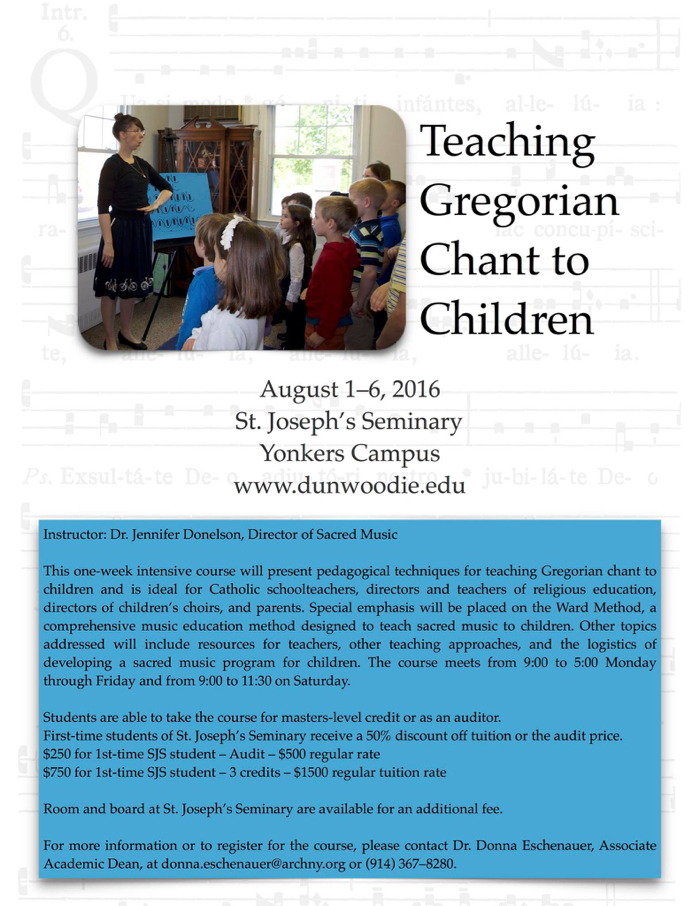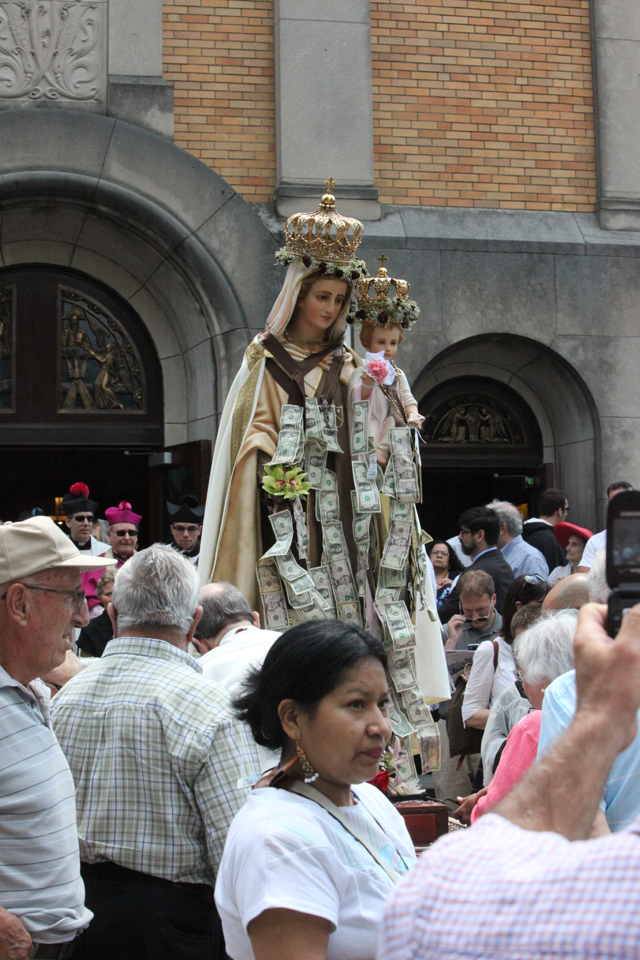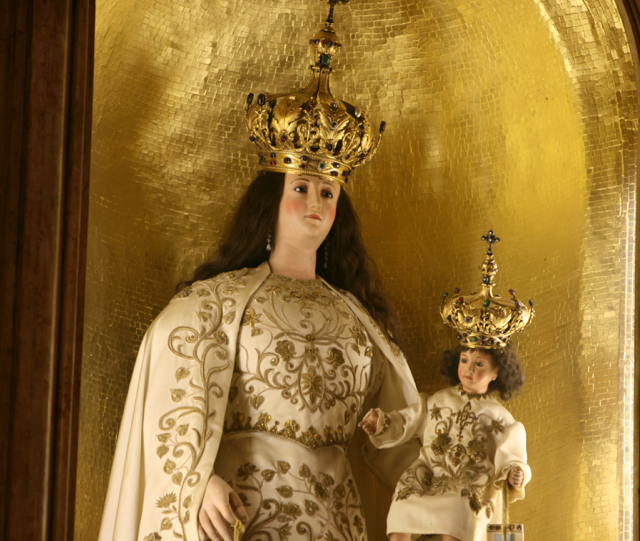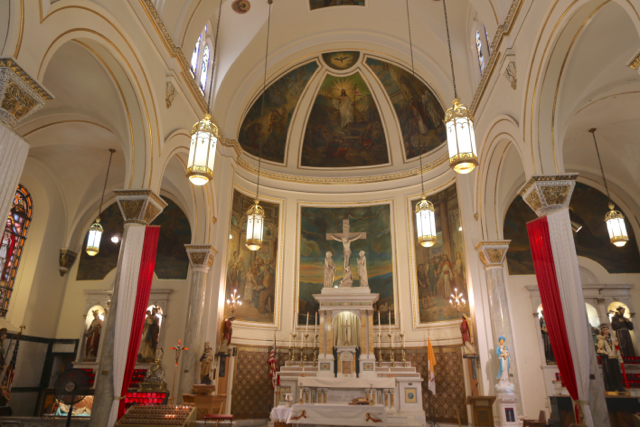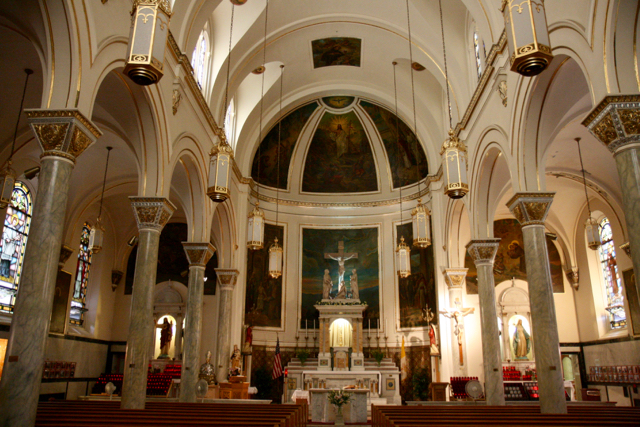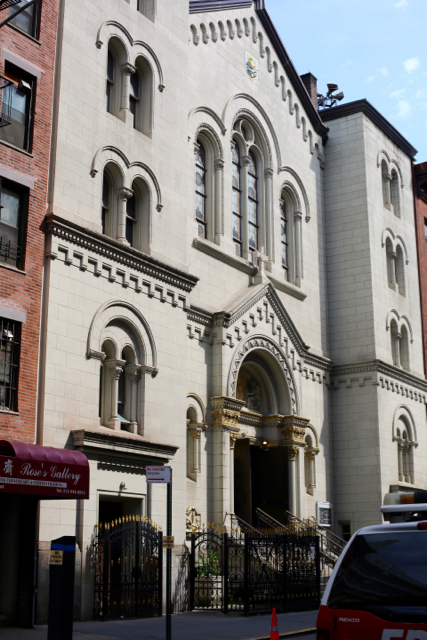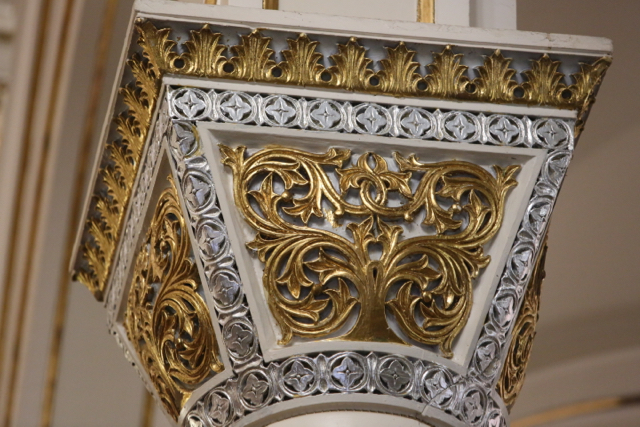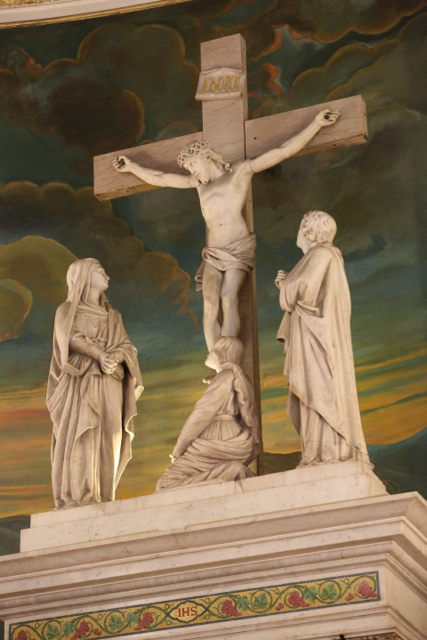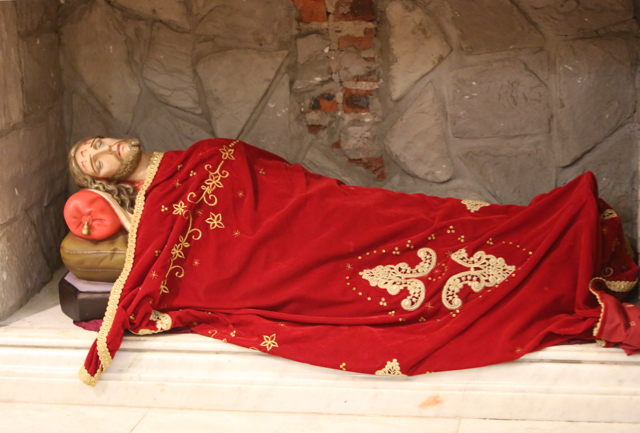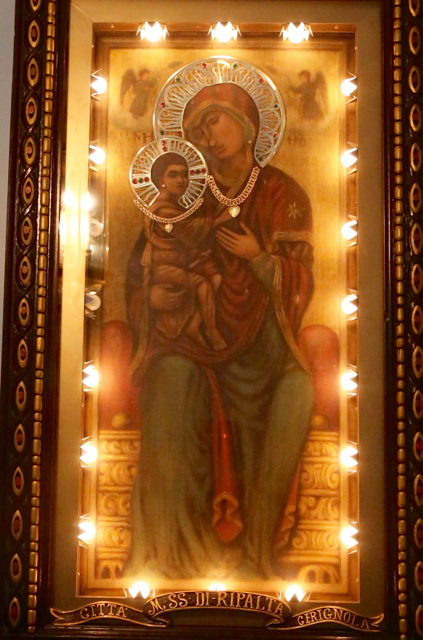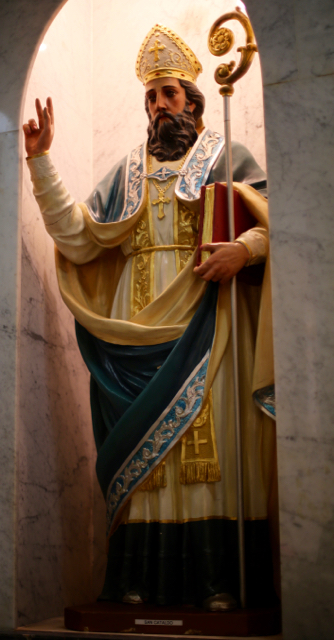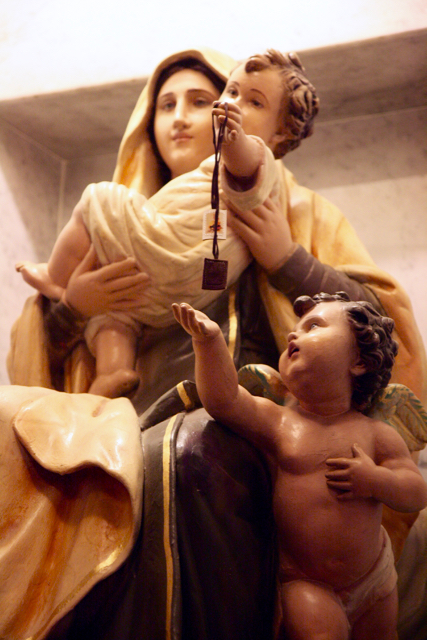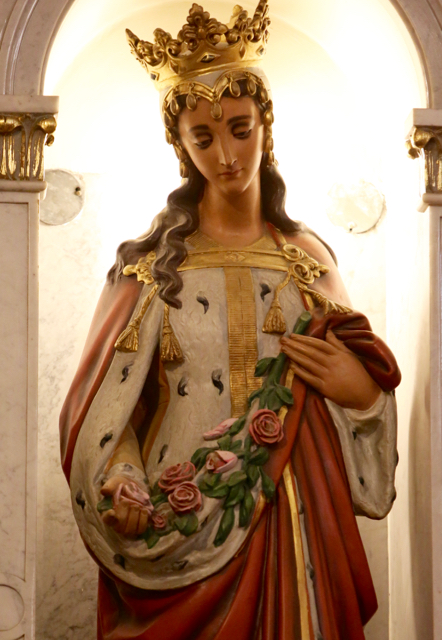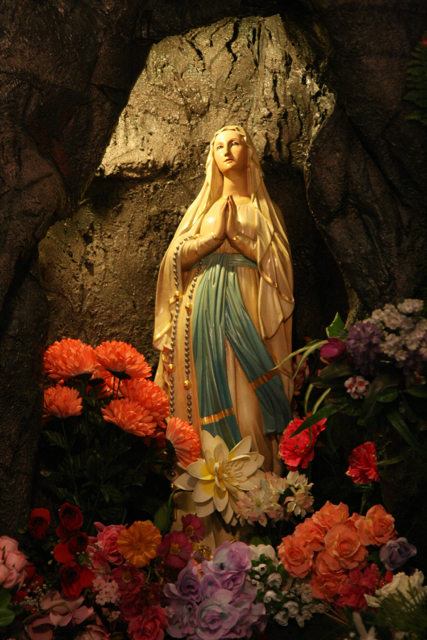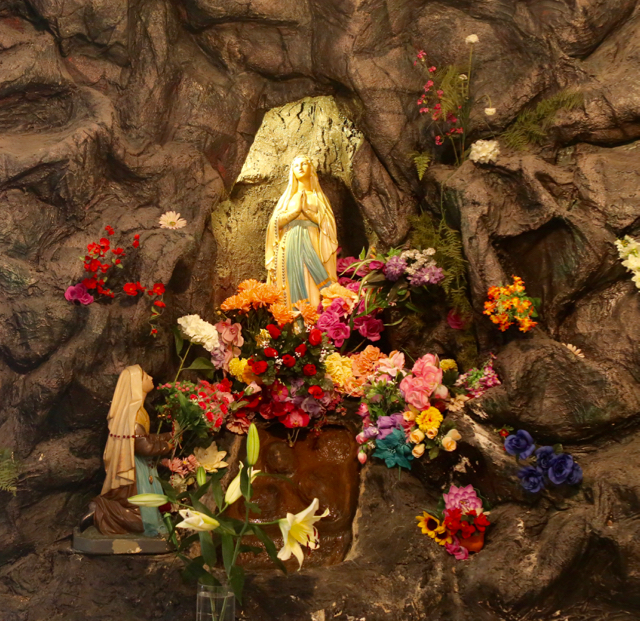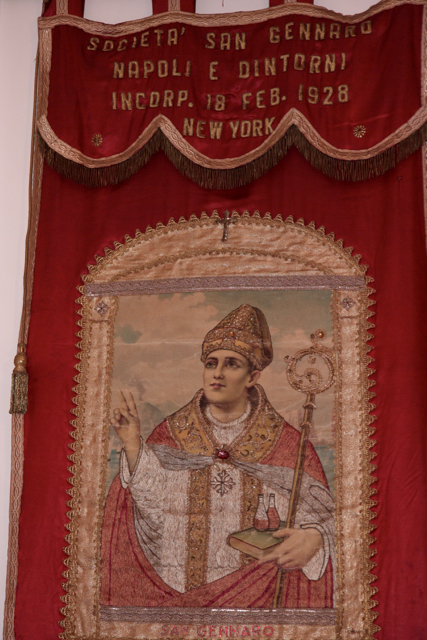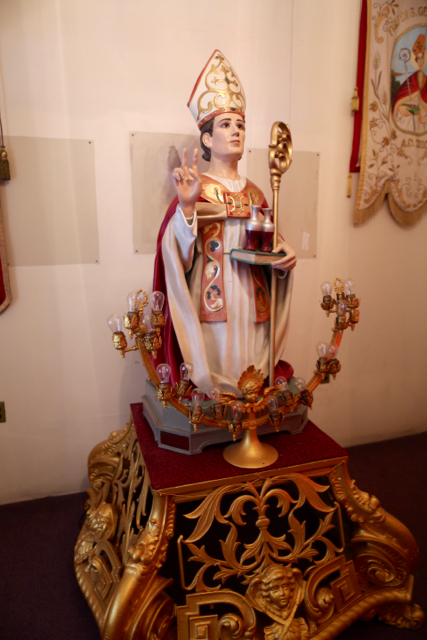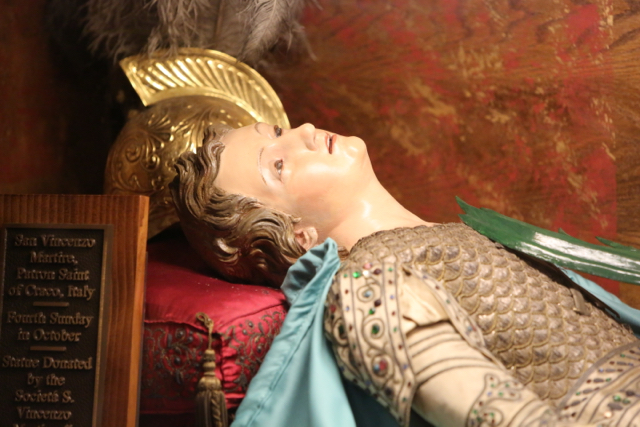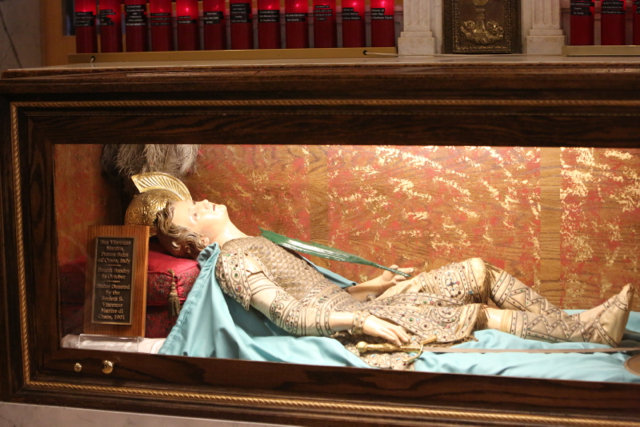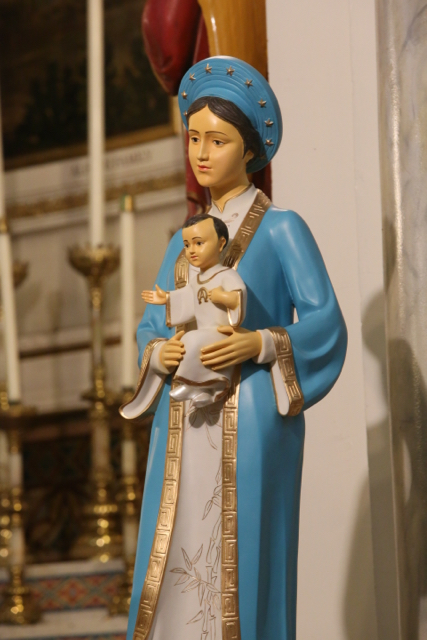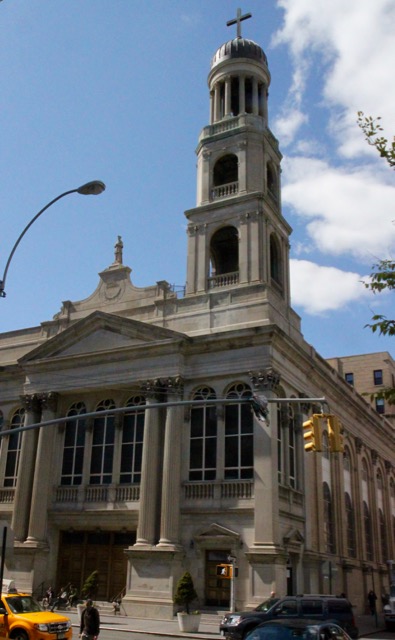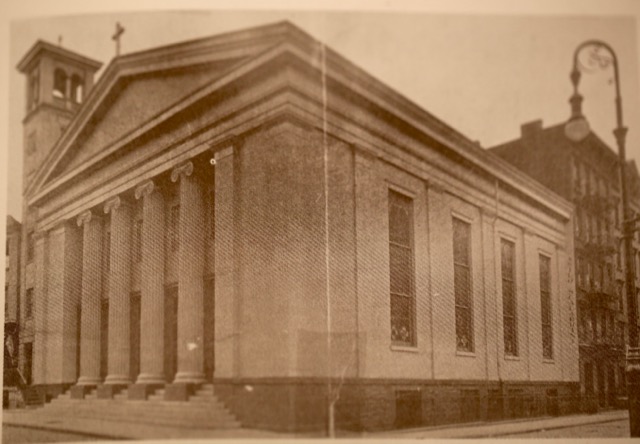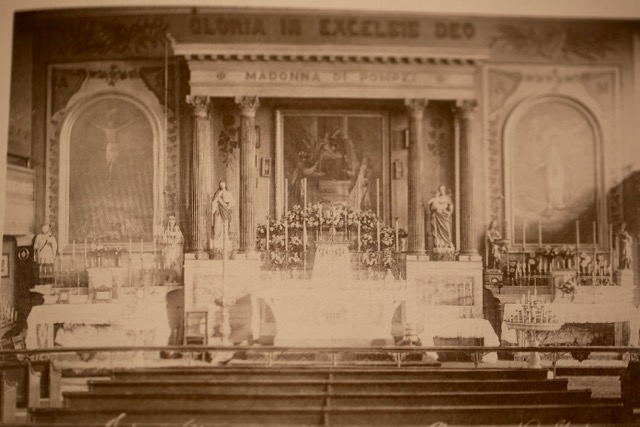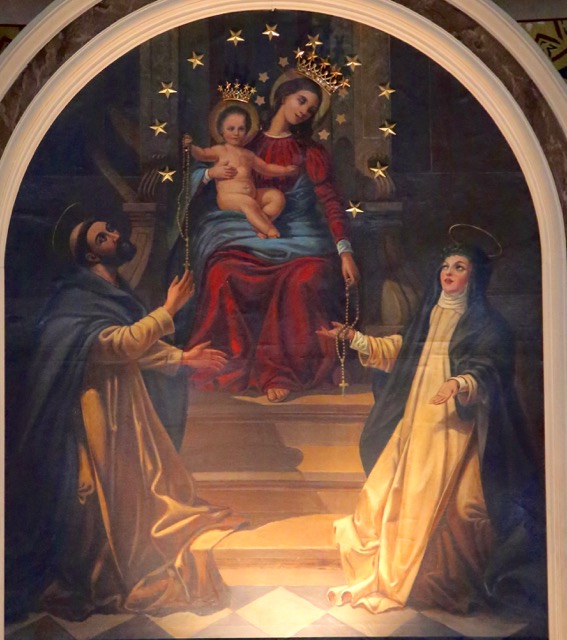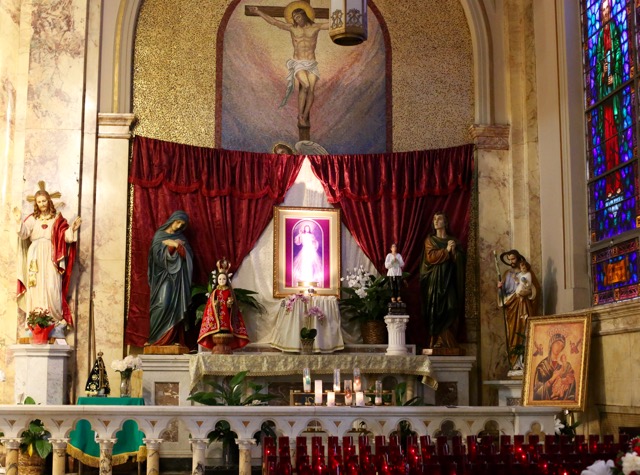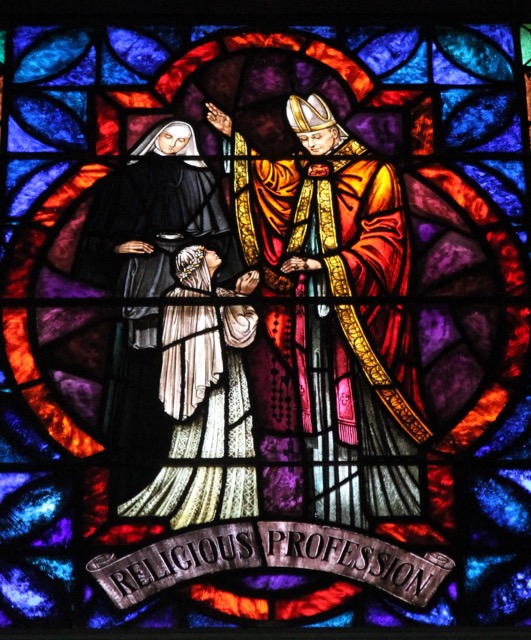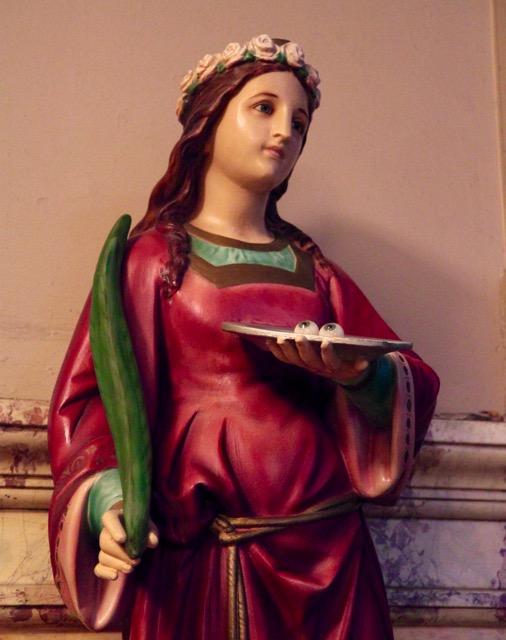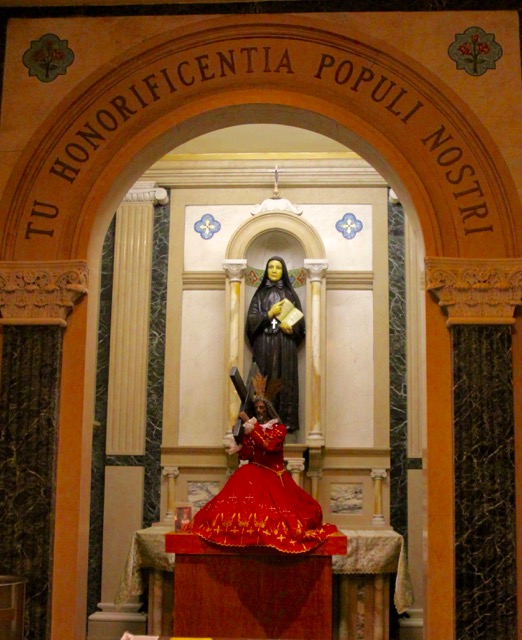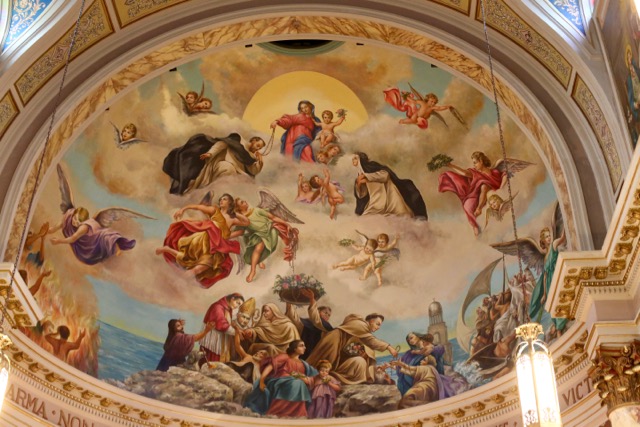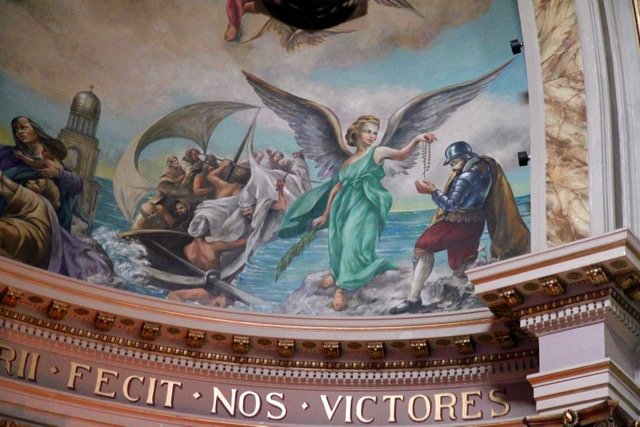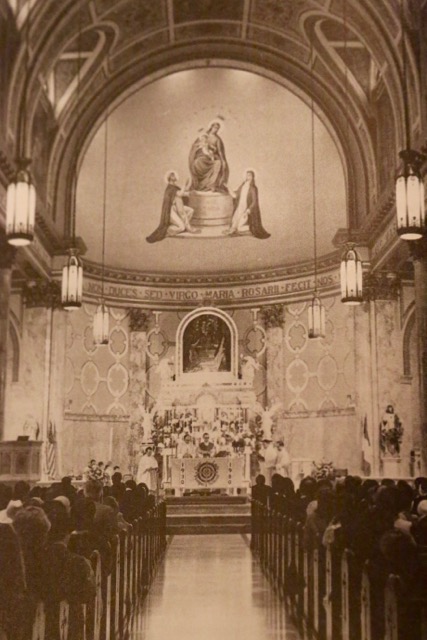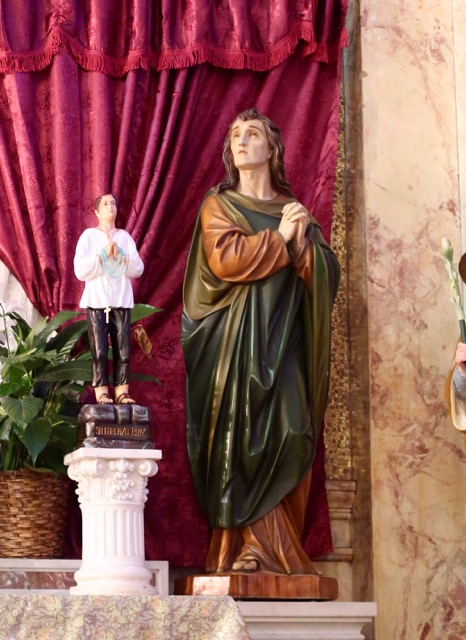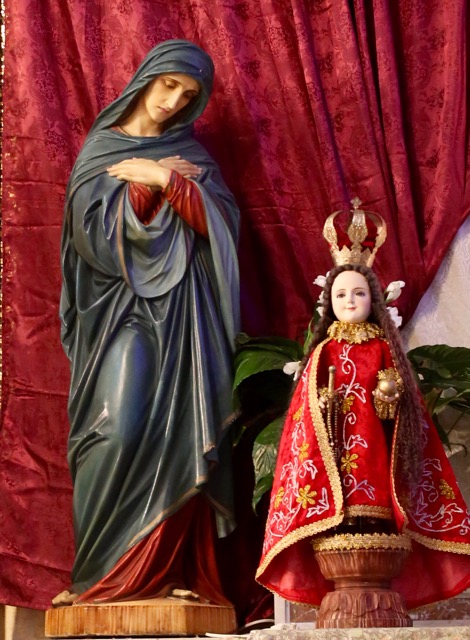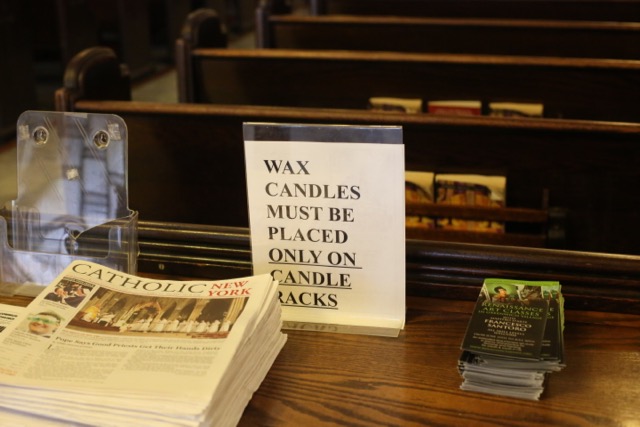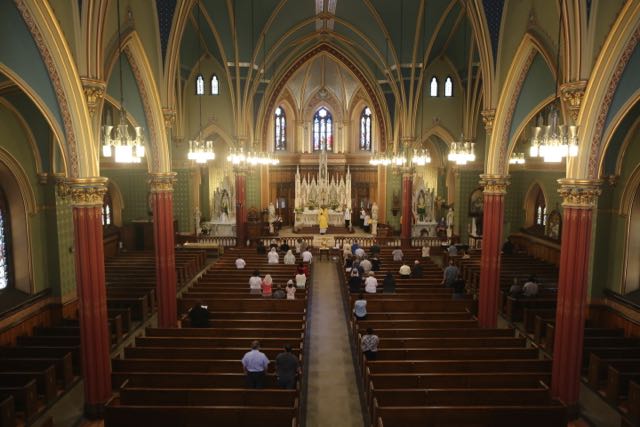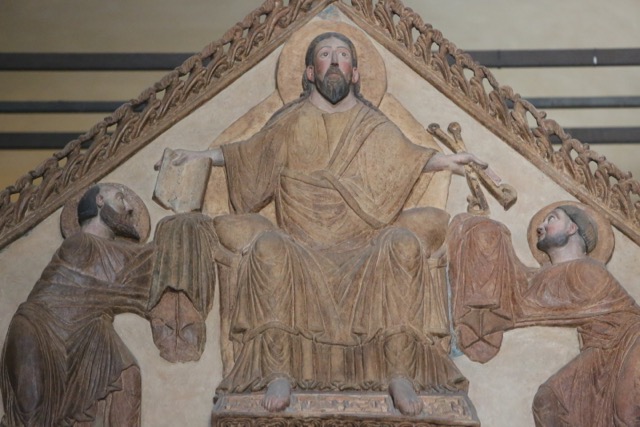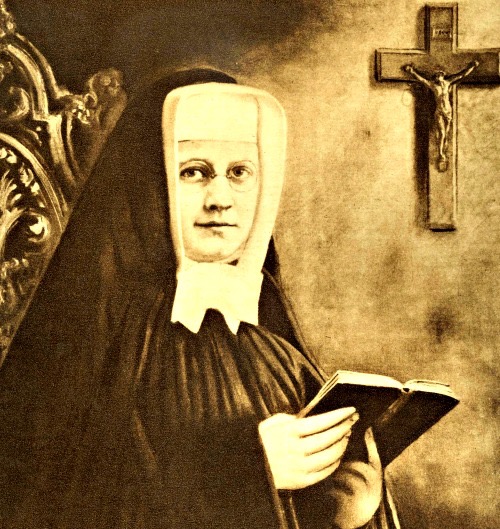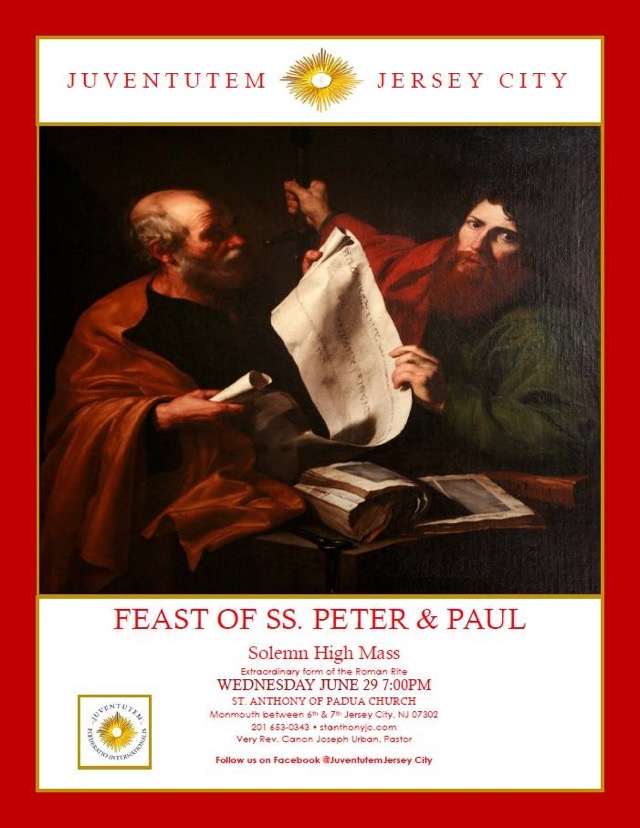15
Jul
7
Jul
On Monday, July 18 (Feast of St. Camillus de Lellis), the parishioners of the Church of the Holy Innocents will have a Going-Away Party for Canon Jean-Marie Moreau — he has been assigned to go to Mauritius. It will start with Mass at 6PM and the reception will be in the parish hall after the Mass.
Anyone who would like to contribute toward this event should contact Mark Froeba (marknf@aol.com) or Eddy Toribio (ejtm83@aol.com).
The following churches will offer the traditional mass for the Feast of Our Lady of Mount Carmel, which is on Saturday, July 16.
The Pontifical Shrine of Our Lady of Mount Carmel, 448 E. 116th Street, New York
Friday July 15 5:30 P.M. – Vigil Low Mass 1962 Missal followed by Exorcism of Salt and Blessing of Holy Water
7:30 P.M. – 1st Solemn Vespers and Benediction of the Most Blessed Sacrament 1961 Breviarum Romanum; Little Office of the Blessed Virgin Mary
9 P.M. – Outdoor Candlelight Procession with Our Lady
Saturday July 16 12:01 A.M. – Solemn Midnight Mass – 1962 Missale Romanum
In addition, the annual traditional pilgrimage to the shrine will take place on Saturday, July 23, 2016 from 10 A.M. – 3 P.M. The focal point of the Pilgrimage will be the Entrance of Pilgrims and Solemn High Mass celebrated according to the 1962 Missale Romanum at 11 A.M. More details about the pilgrimage
Our Lady of Mount Carmel Church (259 Oliver Street),Newark NJ, 12 noon, Solemn Pontifical Mass. The celebrant will be Most Rev. Arthur J. Serratelli, Bishop of the Diocese of Paterson. Mass will be followed by a street procession through the Ironbound.
St. Antony of Padua Church, Jersey City, Missa Cantata, 11 am.
Our Lady of Fatima Chapel, Peqannock, NJ, 9:00 am, followed by the clothing and the profession of the Third Order Carmelites. This will be followed by a reception.
Basilica of Saint John the Evangelist, Stamford, CT, 9:30 am. This is the anniversary of the date the Church was declared a Basilica by Pope Benedict XVI and a special indulgence is granted to all who visit the Church that day and go to Confession, Holy Communion and recite prayers for the intentions of the Holy Father eight days before or after the visit.
St. Mary Church, Norwalk, CT, 9:00 am
Beloved statues of Our Lady of Mount Carmel in the area. At top, Our Lady of Mount Carmel in Newark; just above, Our Lady of Mount Carmel at 116th Street, New York
Shrine Church of the Most Precious Blood
113 Baxter Street/109 Mulberry Street
Nowadays, the only New York Italian church that rivals Our Lady of Pompeii for public recognition is Most Precious Blood fronting on Baxter Street. For it lies in the very heart of “Little Italy” – that prime touristic hot spot in New York. For as long as I can remember the immediate neighborhood of this parish has been a kind of Italian Disneyland with throngs of visitors, souvenir shops, a couple of decent food stores and row upon row of restaurants, some good, many not so good.
But when this parish was organized (in a basement in 1891), Italian immigrants were pouring in. Most Precious Blood, like Our Lady of Pompeii to the north, started as an initiative of the Scalabrini fathers. The effort to manage two immigrant parishes was evidently too much for the resources of the young order of priests. In 1894 the parish was handed over to the Italian Franciscans, already established at nearby St Anthony of Padua. Most Precious Blood then remained a Franciscan parish until 2014. In 1914 this small parish had 15,000 parishioners and witnessed 1167 baptisms, 190 marriages….. 1)
The Franciscans were able to complete the church in 1904 ( it was dedicated by the apostolic delegate to the United States) In 1914 they added a fine stone façade in a Romanesque style. 2) It is very nice – so typical of the fine work lavished in that era upon even minor parishes. The “renaissance” interior of the church, although modest in scale, is balanced and harmonious. And like the exterior, some of the details (like the capitals) are well done.
(Above) The same interior in largely natural light in 2009.
The facade, executed in a fairly standard Romanesque style reminiscent of some Victorian buildings – but also recalling the Norman cathedrals of Southern Italy?
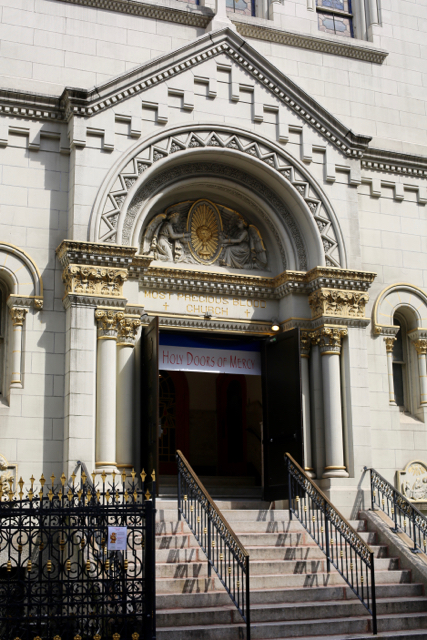
(Above) The elaborate portal as decorated as a “holy door” in 2016.
But, like Our Lady of Pompeii, it not so much the architecture of Most Precious Blood but the decoration that catches our attention – its exuberance forms a stark contrast to the “classical” restraint of the building. For the images, paintings and devotions of this church seem innumerable. Compared to Our Lady of Pompeii, there is a more specific South Italian focus – including intriguing images of the patron saints of less well known towns and villages.
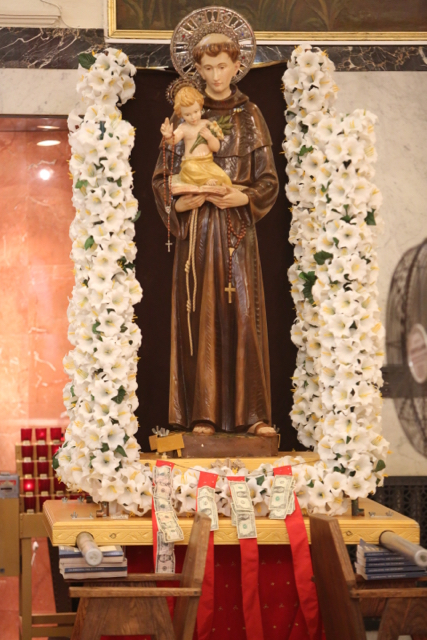
(Above) St Anthony of Padua decorated for a procession.
Some more exotic devotions and patrons:(above) The Madonna di Ripalta from Cerignola in Apulia, near Foggia (copy of the unique thirteenth century icon); (below) Saint Catald, a monk from Ireland (!) bishop of Taranto in the 7th century In addition to Taranto, he is widely venerated elsewhere in Southern Italy and is the patron of, among others, the town of San Cataldo in Sicily. 3)
Some universal devotions have been “Italianized”: (above) The German/Hungarian princess St. Elizabeth is given Italian features; (below) a typical New York Lourdes grotto is transformed by beautiful flowers.
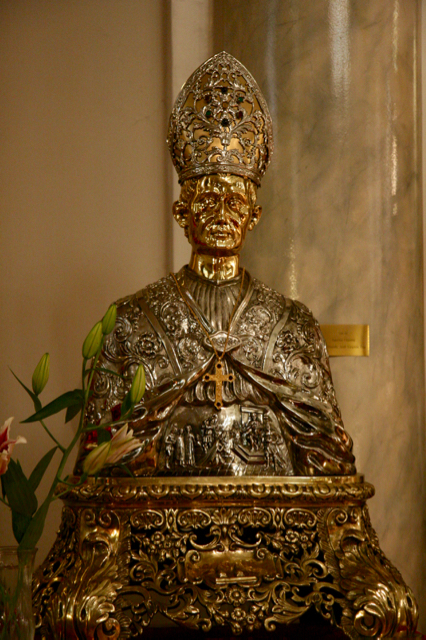
(Above and below) The saint most closely associated in the popular mind with this church: Saint Januarius (San Gennaro) bishop of Naples.
(Above and below) San Vincenzo, patron of Craco (a ghost town in the Basilicata featured in many movies). This image appears to be a newcomer to Most Precious Blood. Not visible in 2009, it was formerly in the church of St Joseph (closed in 2015 under “Making All Things New”). 4)
To explore this church is a strange but calming experience. So many details are unusual and intriguing! Yet, despite the chaos in Mulberry Street outside, very few tourists venture in to disturb the twilight quiet and fewer still stop to pray. At times you do worry whether you yourself have become a ”spiritual tourist.” In 2016 there may be much more traffic than in recent years, given that Most Precious Blood has been designated to have a “Holy Door of the Year of Mercy.”
Most Precious Blood is most famous, of course, for its association with September’s San Gennaro Festival: the longest, loudest, best known but least religious and least attractive Festa, perhaps, in all of North America. It is a relative latecomer to the parish first having been celebrated – as a one-day affair – in 1926. In 1994 Mayor Giuliani forced a handover of the leadership of the festival to a new organization because of alleged Mafia infiltration. 5) In recent years, however, stories have been published alleging continuing Mafia connections and questioning the use of the festival’s funds even under the new sponsoring organization.6)
Most Precious Blood had been magnificently restored in the 1990’s. But by 2014 the congregation had dwindled to few hundred. The last Franciscan pastor, 88-year old Fr. Fabian Grifone, celebrated his last mass in the parish early that year and the Franciscans gave up their mission here after 120 years. 7) It looked like Most Precious Blood would be “low-hanging fruit “ for the “Making all Things New “ planners – especially given that spiritual, historical and aesthetic factors counted for nothing. Despite this church’s location in a tourist zone, general indifference seemed to prevail regarding the likely fate of this church.
But then something unusual happened. Most Precious Blood had in recent years also become the spiritual home of the city’s Vietnamese Catholic community. Of the 400 people who attended four masses on the weekend, 200 attended the Vietnamese language mass at 2 PM on Sunday. 8) The Vietnamese must have made their objections known, because Cardinal Dolan stated that reasons for not approving recommendations to close a parish included:
“special considerations for unique groups. For instance, one parish suggested to close was also serving the deaf community, another welcoming people who desire the Latin Mass, another the Vietnamese Catholics, all of whom, while not living within the parish neighborhood, were still in need of pastoral care and a spiritual home.” 9)
I believe in the case of the last church Cardinal Dolan is referring to Most Precious Blood.
So did Our Lady of Lavang, whose image is one of the latest additions to the devotions of Most Precious Blood, stretch out her protecting hand over this church?
Since 2015 Most Precious Blood church is no longer a parish but the “Shrine Church of the Most Precious Blood” a chapel of St. Patrick’s church to the north. Is this twist of fate not appropriate? – was not for many decades Old St. Patrick’s itself de facto an Italian ethnic parish? On Sunday, however, only one mass is now celebrated at the shrine – in Vietnamese. 10) And yet in this year one of the Archdiocese’s Holy Doors is located here. Perhaps this bodes well for the future – perhaps it will attract visitors who, instead of just seeking out food and raucous festivity , feel somehow called to rediscover their heritage both spiritual and historical.
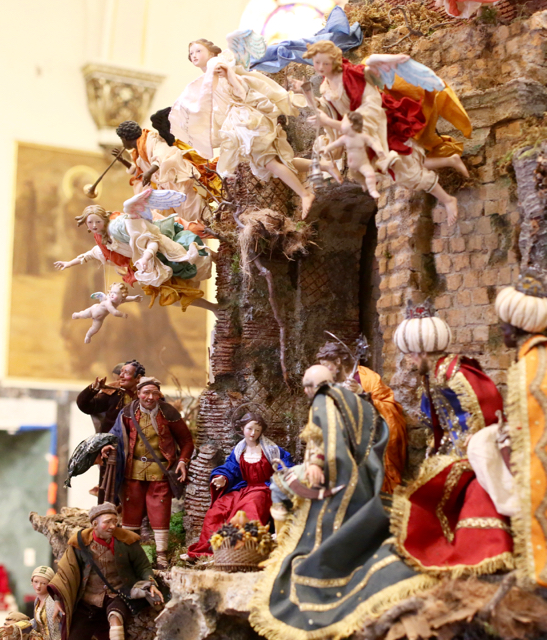
(Above) A typically elaborate Neapolitan Christmas creche is now set up in the back of the church (all year round?)
A new addition (apparently since 2009): Our Lady of Lavang, a Vietnamese devotion. But she apparently played a key role in saving this church!
1) The Catholic Church in the United States of America, Vol. 3 at 352; Vol. 1 at 236-37. (Catholic Editing Company, New York 1914).
2) The Catholic Church in the United States of America, Vol. 1 at 236-37.
3) https://it.wikipedia.org/wiki/Madonna_di_Ripalta; https://en.wikipedia.org/wiki/Catald
4) https://en.wikipedia.org/wiki/Craco; https://en.wikipedia.org/wiki/Vincenzo,_Martyr_of_Craco
5) Tonelli, Bill. “Arrivederci, Little Italy”. (New York Magazine, September 27, 2004).
6) e.g., http://www.nytimes.com/2012/04/19/nyregion/mob-is-back-at-san-gennaro-festival-officials-say.html?_r=0; http://www.nydailynews.com/new-york/nyc-crime/exclusive-feast-san-gennaro-lights-mobsters-records-show-article-1.1946299
7)http://www.nydailynews.com/new-york/priest-celebrates-mass-precious-blood-church-article-1.1708612
8)http://thevillager.com/2014/03/13/little-italy-parish-saddened-by-pastors-retirement/
9) http://cardinaldolan.org/index.php/making-all-things-new-update/ (July 1, 2014)
10) http://www.oldcathedral.org/mass-times
2
Jul
Our Lady of Pompeii
28 Carmine Street
If you wander south on Sixth Avenue in the Village you’ll find at the intersection with Bleecker Street a small park offering some respite from the surrounding aesthetic and moral decrepitude. And towering over the park – named after a Catholic priest – is a church enjoying an unusually prominent and visible location. A tall tower and baroque facade surmount a somewhat institutional exterior with large windows resembling those of an old-time library or school. A step inside, however, reveals an incredibly extravagant, bright and colorful vision. In a Renaissance-style church interior, innumerable statues surround elaborate marble altars and also line the sides and rear of the nave. Paintings, mosaics and stained glass seem to cover every surface, crowned by a grandiose mural of Our Lady of the Rosary over the sanctuary. It is an exuberant, overflowing Catholicism that can be found only in an Italian ethnic parish – that is, if we ignore certain earlier German, Slavic and even “Irish” parishes of the city.
Now St. Anthony of Padua, a few blocks to the south, may be the oldest Italian Catholic church in Manhattan. Our Lady of Mount Carmel in East Harlem may be the most impressive and important in New York Italian-American history. Yet, I am sure that whenever a New Yorker thinks about an “Italian church” nine times out of ten it is this one. For it is big, lavishly decorated and occupies a very prominent site in a well-known part of town. An area, moreover, that remained a relative safe zone for visitors throughout the high crime decades of the City.
At the time of the founding of this parish, devotion to Our Lady of Pompeii was recent but flourishing. A shrine had been organized in 1875 in Pompeii by a layman, Blessed Bartolo Longo. Eventually a grandiose sanctuary was built there that still attracts pilgrims from all over Italy. In the 1890’s Italian immigrants were flooding New York. The “Saint Raphael Society for the Protection of Italian Immigrants” (an Italian benevolent society), the order of St Charles Borromeo (the Scalabrini fathers) and a wealthy Irish benefactor, Annie Leary (of upper Fifth Avenue), helped organize the new parish in 1892. In 1898 the parish of Our Lady of Pompeii was able to acquire a modest if dignified permanent home. An old Unitarian “temple” (of the same style and era as nearby St Joseph’s Catholic Church) on 210 Bleecker Street had been the home of St. Benedict the Moor – the first parish for black Catholics in New York, organized in 1883. Because of the shift of the black population north, that parish was moving uptown to a new home on West 53rd street. Our Lady of Pompeii moved in. Countess Leary donated the copy of the image of Our Lady of Pompeii that adorned the altar and otherwise continued to provide major support to the fledgling parish. From the beginning until the present day this parish has been directed by the Scalabrinian Fathers. Despite the dedication of the parish, many of the original parishioners came from Genoa. 1)
Strange: the old parishes of New York so often originated in individual initiatives by diocesan or religious clergy, laity and wealthy donors – or in the case of Our Lady of Pompeii, all three together. It contrasts with rigidly centralized top-down management of the archdiocese today! And, as in many other cases, the image currently propagated of the 19th century Church – exclusive clericalism, universal grinding poverty, animosity between Irish and newer immigrants – needs extensive nuancing.
Now the key figure in the era of the parish’s greatest growth was Father Antonio Demo, pastor from 1899 to 1933. He supervised the conversion and decoration of the former church of St Benedict the Moor. Amid many struggles, he managed the massive increase in size of the Italian population in South Greenwich Village:
The Catholic population (of Our Lady of Pompeii parish) of 25,000 shows an increase of 5000 in five years due to emigration and, principally, to naturally growth. During Father Demo’s first year as pastor there were 180 marriages snd 400 baptisms; in 1912 the figures were baptisms 1420 and marriages 468; and in 1913: 1352 baptisms and 432 marriages. 2)
The old church must have been grossly inadequate – but soon relief came from an unanticipated development. In 1923, Sixth Avenue was to be lengthened to the south and Our Lady of Pompeii was squarely in its path. The old church was demolished and Fr. Demo built the present lavish new structure, completed in 1928. It was a combination of church, school, convent and attached rectory. Given the high cost of land in Manhattan, such multipurpose structures were often built in New York City in that era – one thinks of Corpus Christi parish, the recently closed St. Stephen of Hungary or what is now the “Villa Maria.” But none of these are on the scale of Our Lady of Pompeii! Moreover, the tall solitary tower facade recalls vaguely the tall, stand-alone campanile of the original shrine in the “old country.” A parochial school was opened in 1930 staffed by the “Zelatrices” (after 1967, the “Apostles” of the Sacred Heart).3) The bulk of the decoration of the church – high altar, murals and windows – was completed between 1934 and 1941. 4) Regrettably, Father Demo himself did not see most of this: he had effectively resigned the pastorate in 1933 amid worsening economic conditions and died in 1936. 5) The park in front of the church was named after him in 1941.
But after the sacrifices of the first years Our Lady of Pompeii prospered now as a comfortable middle-class parish – until the 1970’s. It’s perhaps a surprise to some that Greenwich Village, along with Stuyvesant Town, remained perhaps the last significant outpost of the Catholic middle class on the island of Manhattan. The exclusively ethnic character of the Our Lady of Pompeii parish gradually eroded: already by 1940 at some masses the sermons were given in English.6)
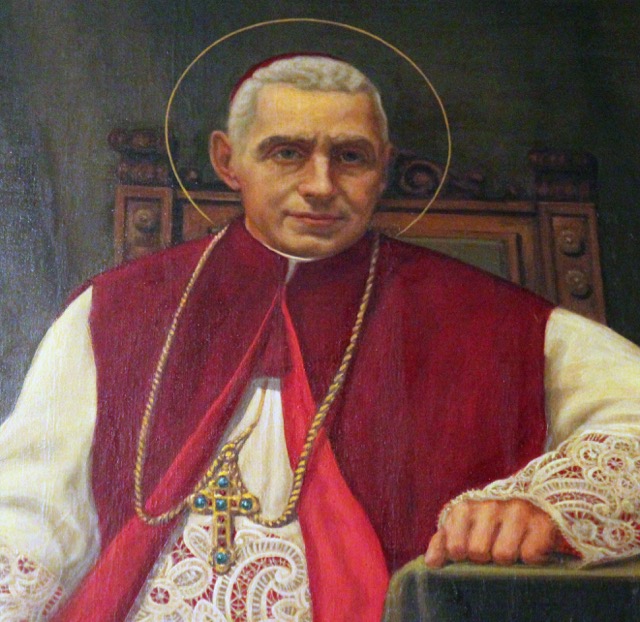
(Above) Blessed Giovanni Battista Scalabrini, Bishop of Piacenza and the founder of the Missionaries of St Charles Borromeo (the “Scalabrini Fathers”), as depicted in a painting in Our Lady of Pompeii.
![nationalcyclopae14newy_0804[1]](https://sthughofcluny.org/wp-content/uploads/2016/06/nationalcyclopae14newy_08041.jpg)
(Above) Countess Annie Leary (her title was papal) was a wealthy, exceedingly generous, but strong-willed and often difficult woman. She was a colorful figure in New York society and Catholic charity up till her death in 1919. In addition to her support of various initiatives to aid Italian immigrants (including the founding of Our Lady of Pompeii), she created a Catholic chapel at Bellevue hospital (the magnificent Munich stained glass from that building is still at Bellevue), funded the erection of the statue of Christoper Columbus on Columbus Circle and helped the contemplative order of nuns of St Mary Reparatrix come to New York and take over the parish of St Leo. She is buried under Old St. Patrick’s Cathedral.
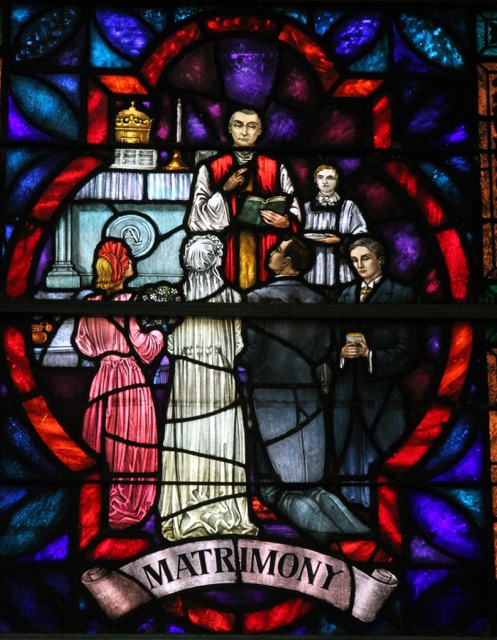
(Above) The priest in this stained glass window from the late 1930’s is said to have the features of Fr. Antonio Demo. 7) He oversaw the fantastic expansion of the parish and the building of the present church.
(Above and below) The 1836 Unitarian “temple” on Bleecker street acquired by Our Lady of Pompeii in 1898 from the congregation of St. Benedict the Moor. Already the interior decoration was lavish – if on a much smaller scale than in today’s church. 8)
(Above) The copy of the image of Our Lady of Pompeii above the main altar. According to the parish history, this is the original painting given to the new parish by Countess Leary – if so, it has been cut down to fit this frame. 9)
(Above and Below) These pictures give some idea of the profusion of images in this church. Images of Brazilian and Filipino devotions supplement the original Italian inventory.
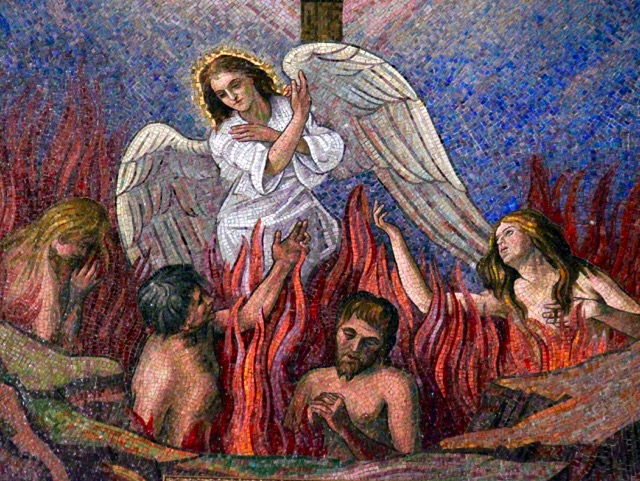
(Above) A sign of today’s Church? This mosaic of the poor souls in purgatory is now ( June 2016) covered by the backdrop for the “image of mercy.” See photograph immediately above this image.
(Above) This image of “religious profession” was added to fill out an eighth window panel in a cycle of the seven sacraments. One of the nuns teaching at the school is supposed to have posed for this window. 10)
(Above and below) Two saints who never fail to appear in Italian parishes! Before 1900, moreover, Mother Cabrini was associated briefly with this parish while organizing a school for Italian girls – naturally, also in collaboration with Countess Annie Leary. 11)
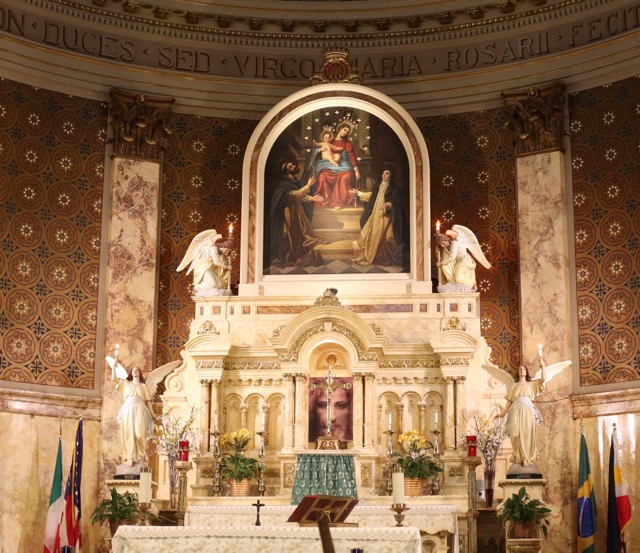
(Above) The main altar – featuring angel-borne electric torches and the the recent insertion of a somewhat startling image of the “Holy Face.”
(Above) The grand mural of Our Lady of the Rosary. (Below) This detail and the inscription refer to the battle of Lepanto.
In the 1970s Our Lady of Pompeii was caught up in the great crisis of Catholicism in New York and the world. The old parishioners steadily moved to the suburbs. The population of the parish took on a profile like so many others in New York City:
– The original parishioners and their descendants, who, although largely residing outside the boundaries of the parish and even of the city continued to return to Our Lady of Pompeii and provide generous support;
– Those marginalized by the relentless, pitiless onward march of life in the capital of modernity: the elderly, the poor, those suffering from various addictions; and
– The new immigrant groups: in the case of Our Lady of Pompeii, Brazilians and Filipinos.
Vatican II, as always, made a major contribution to this crisis. The parish history makes clear that this parish went through a traumatic time particularly between 1970 and 1975. The most dramatic step was the removal and repainting of the mural that is the centerpiece of the church. You see, this painting of Our Lady of the Rosary contained images of the poor souls in purgatory and of the battle of Lepanto that were and are anathema to the Conciliar Church. But then events took a very different turn from those at Our Lady of Pompeii’s next-door neighbor to the north, St. Joseph’s. In contrast to the total housecleaning pushed through there, real resistance emerged at Our Lady of Pompeii. The removal of the mural was but the preface to the pastor’s proposed wholesale restructuring of the sanctuary. A poll was taken of the parishioners and of 220 who responded only 40 chose the option “to change in conformity with Vatican II”; 114 wanted no change at all. Further renovations were stopped. The pastor resigned; indeed, there were a half-dozen pastors of this parish in the period 1964 to 1976. 12) In 1985, amid the jubilation of the parish population,a copy of the original 1937 mural replaced the “Vatican II” version. 13) This is one of the few successful instances of resistance to the so-called Vatican II reforms in New York of which I am aware.
Since then things have calmed down. The parish positioned itself more and more as a “Shrine” of Our Lady of Pompeii transcending diocesan boundaries. An annual Serata Italiana brings back old parishioners and hopefully attrracts newcomers. The parochial school has continued to function: a rarity in New York City parishes. Moreover, in contrast to many others, Our Lady of Pompeii school emphasizes its Catholic identity. The parish played more and more the role of a provider of social services.
And of course there is the steady stream of tourists visiting the Village. Some drop in now and then to admire the decor of this resolutely non-modernist church. It is the extravagant interior – truly Catholic and Italian -that draws them. It captures the overflowing and superabundant nature of grace and of creation. To the many devotions established by the Italian parishioners new immigrant groups have added their own statues and pictures. It is the very nature of Traditional Catholicism as opposed to Conciliar Catholicism: a multitude of paths to the Divinity open to the individual believer, not a exclusive focus upon a priest celebrating the “liturgy” in a bare room. And yet, it’s not a jumble of individualistic caprices, but “it all hangs together” (Eric Gill) in wondrous harmony!
Admittedly, a closer inspection of the statues and the stained glass reveals that, generally speaking, they are not of the absolutely highest quality. As in other lavishly decorated Italian parishes (one thinks of Precious Blood in Little Italy or of Our Lady of Peace) these parishes at first lacked the financial resources of mainstream Archdiocesan parishes and those of religious orders. Then, by the time funds did become available for more ambitious programs of decoration, the quality of Catholic religious art had already started to decline. But the overall impression is magnificent: what sacrifices must have been made to achieve this decoration and, even more so, to restore and preserve it!
(Above) The 1975 “Vatican II” painting in the apse, as seen in a photograph from 1980. 14)
If I am not mistaken, in the recent past more concrete elements of tradition long thought dead also have reared their head. The words of the pastor in the church bulletin are eminently solid. A course in traditional artistic techniques has been offered at the parish. And even a Solemn Traditional Mass was celebrated at Our Lady of Pompeii. Does this indicate the opening of an unexpected path to the evangelization of the neighborhood of this parish? Building on the great legacy of the past but moving beyond nostalgia and folklore, does the fullness of Tradition offer a way to establish contact with the many non- or even anti-Christians who now dwell in affluence where impecunious immigrant Italians did generations ago? For it is clear that the other path (adopted by Our Lady of Pompeii’s next door neighbor, St. Joseph’s in the Village, in the 1970s) of accommodation to the mores of the neighborhood, the city and of the “American Catholic Church,” led in the end nowhere.
I would be the first to admit that a project of evangelization in this area and at this time indeed would require a “leap of faith!” But with God all things are possible – and wasn’t the beginning of this parish – for different reasons – a challenge to evanglization too? Fortunately, thanks to the sacrifices of prior generations, Our Lady of Pompeii has a beautiful church and a functioning parish with which to start.
(Above and below) These statues of Our Lady and St John are of a different style and of a higher artistic quality than the rest of the decor. Originally part of the furnishings of the church of St. Benedict the Moor, they were removed to that congregation’s new church in 1898. In 1979, when St Benedict the Moor’s interior was being “renovated” they were handed back to Our Lady of Pompeii. They now share space with more recent devotional images. 15)
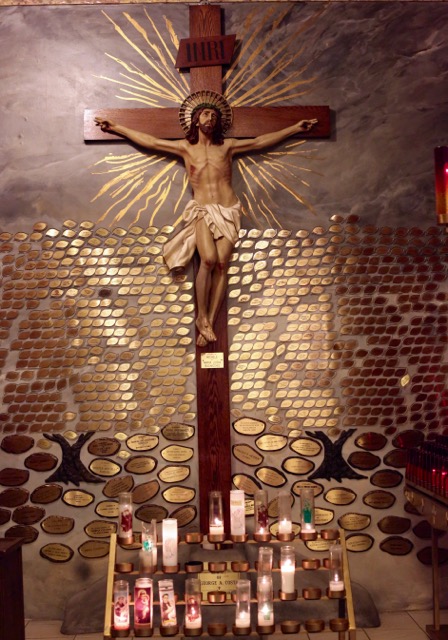
(Above) The two statues in the previous photographs once flanked this crucifix, which, like them, is of higher artistic quality than the rest of the church decor. The crucifix was bequeathed by the parish of St Benedict the Moor to Our Lady of Pompeii in 1898. It has been located in this shrine in the new church of Our Lady of Pompeii since the 1920’s. 16 )
(Above) It’s hard to restrain Catholics practicing traditional devotions….
See the parish website – featuring a virtual tour of the church! There is an exceptionally fine parish history by Mary Elizabeth Brown: From Italian Villages to Greenwich Village: Our Lady of Pompei 1892-1992 ( Center for Migration Studies, 1992, New York). See also, by the same author: The Italians of the South Village (The Greenwich Village Society for Historic Preservation, 2007, New York)
1) Brown, From Italian Villages at 15- 19, 21-23
2)The Catholic Church in the United States of America, Vol. 3 at 360. (Catholic Editing Company, New York 1914)
3)Brown, From Italian Villages at 82-86;88-89.
4)Brown, From Italian Villages at 103-104, 106-107.
5) Brown, From Italian Villages at 98-99.
6)Brown, From Italian Villages at 110-11. The parish history helpfully adds “In 1940, all masses were in Latin.” Ibid. at 111.
7) Brown, From Italian Villages at 107.
8) Brown,From Italian Villages at 11.
9) Brown, From Italian Villages at 89.
10) Brown, From Italian Villages at 107
11) Brown, From Italian Villages at 25; Brown, The Italians of the South Village at 50.
12) Brown, From Italian Villages at 143-47.
13) Brown, From Italian Villages at 163-64.
14) Brown, From Italian Villages at 136.
15) Brown, From Italian Villages at 154-55
16) Brown, From Italian Villages at 155.
The fifth annual Traditional Mass Pilgrimage at The Pontifical Shrine of Our Lady of Mount Carmel, New York, will take place on Saturday, July 23, 2016 from 10 A.M. – 3 P.M. The focal point of the Pilgrimage will be the Entrance of Pilgrims and Solemn High Mass celebrated according to the1962 Missale Romanum at 11 A.M. The shrine address is 448 E. 116th Street, New York, NY.
Pilgrims will be welcomed at 10 A.M. by our Pastor, Father Marian Wierchowski SAC, a Priest of the Pallottine Fathers. Spiritual Talks of a Marian Motif will be delivered by priest pilgrims. We also will have priests hearing confessions before and during Mass for pilgrims who wish to avail themselves of the Sacrament.
There will be a Plenary Indulgence granted by devoutly visiting the Shrine, Receiving the Sacraments of Penance and Holy Communion within twenty days, being free from attachment to sin, and praying for the Intentions of Our Holy Father.
Pilgrims may choose to process down the nave of the Church walking on their knees or discalced, or remain in their pews. Thereafter, the Solemn High Mass will begin. The Mass to be Celebrated will be the Second Class Votive Mass of Our Patroness, Our Lady of Mount Carmel, which can be found in your hand missals under the Proper of the Saints on July 16.
Following the Mass, Pilgrims may elect to have Lunch in one of the many neighborhood restaurants, or have lunch in the Parish Undercroft, during which the Martyrology will be Chanted and spiritual talks delivered, a venerable practice adopted from Seminary Refectories, Abbeys, Convents and Monasteries.
At 2:15 P.M., Pilgrims will be invited to Enroll in the Brown Scapular by the Pallottine Fathers. It is said that those who are faithful and die wearing the Brown Scapular will be released from Purgatory on the Saturday following their death, known as the Sabbatine Privilege. Pilgrims will have an opportunity to Recite the Most Holy Rosary. The Pilgrimage will conclude with Benediction of the Most Blessed Sacrament and Farewell of Pilgrims.
10 A.M. – Welcoming of Pilgrims
10 A.M. – Sacrament of Penance, Confessions Heard
10;15 A.M. – Marian Spirilual Talks
11 A.M. – Entrance of Pilgrims
11:15 A.M. – Solemn High Mass – 1962 Missale Romanum
12:45 P.M. – Pilgrims may have an Independent Lunch in the Neighborhood or have Lunch in the Parish Hall, during which the Martyrology will be Chanted (a practice observed in Seminary Refectories, Convents, Monasteries, Abbeys etc) and a Spiritual Talk delivered by a Priest
2:15 P.M. – Investiture in the Brown Scapular by the Pallottine Fathers;
2:30 P.M. – Eucharistic Adoration; Recitation of the Rosary; Benediction of the Most Blessed Sacrament
3 P.M. – Farewell of Pilgrims
Bus Directions: M116 or M15 SBS Buses to 116th Street and 1st Avenue; Walk East Past First Avenue to Church
Subway Directions: 6, C, 2 or 3 Trains to 116th Street; Wait for M116 Bus or Walk East Past 1st Ave to Church
Parking is Available in the Neighborhood, as well as the Costco Shopping Complex East of Pleasant Avenue
The Shrine is also nearby the Tri-Boro RFK Bridge to the Bronx and Queens,
the FDR drive along the East River, and the 125th Street Metro North Station
Other Traditional liturgies on the schedule for the Feast of Our Lady of Mount Carmel:
Friday July 15 5:30 P.M. – Vigil Low Mass 1962 Missal followed by Exorcism of Salt and Blessing of Holy Water
Friday July 15 7:30 P.M. – 1st Solemn Vespers and Benediction of the Most Blessed Sacrament 1961 Breviarum Romanum; Little Office of the Blessed Virgin Mary
Friday July 15 9 P.M. – Outdoor Candlelight Procession with Our Lady
Saturday July 16 12:01 A.M. – Solemn Midnight Mass – 1962 Missale Romanum
Mass in the Extraordinary Form of the Roman Rite will be held at the Basilica of Saint John the Evangelist in Stamford on Saturday, July 16 at 9:30 in the morning to celebrate the Feast of Our Lady of Mt Carmel. This is the anniversary of the date the Church was declared a Basilica by Pope Benedict XVI and a special indulgence is granted to all who visit the Church that day and go to Confession, Holy Communion and recite prayers for the intentions of the Holy Father eight days before or after the visit.
30
Jun
This Sunday, July 3rd, a Missa Cantata will be offered at Immaculate Conception Church in Sleepy Hollow, NY, for the external solemnity of Saints Peter and Paul.
Following the mass, the newly ordained Rev. Jon Tveit will give his first priestly blessing, and a reception will be held in his honor.
The image of Saints Paul and Peter appears on the baldecchino of the Basilica of St. Ambrose in Milan.
Canon Jean Marie Moreau will lead a pilgrimage to the shrine of Blessed Miriam Teresa Demjanovich
When: Saturday, July 9, 2016 9:30 am – 12:30 pm
Where: Meet at the Holy Family Chapel
Sisters of Charity of St. Elizabeth, Convent Station NJ 07961
Beginning at 9:30 am – Stations of the Cross
Followed by a Solemn High Mass in the Extra-Ordinary Form (Latin Mass)
More Info: Canon Jean Marie Moreau, Institute of Christ the King
St. Anthony of Padua Oratory
1360 Pleasant Valley Way, West Orange, NJ 07052
973-325-2233
Wednesday, June 29th, in honor of the Feast of Sts. Peter and Paul, the newly formed Juventutem Chapter of Jersey City will celebrate a Solemn High Traditional Latin Mass at 7:00 p.m at St. Anthony of Padua Church. The mass features Haydn’s Missa Brevis, Tu Es Petrus by Palestrina for 6 Voices, Bone Pastor by Tallis, Exsultate Justi by Lodovico da Viadana.
Contact us
Register
- Registration is easy: send an e-mail to contact@sthughofcluny.org.
In addition to your e-mail address, you
may include your mailing addresss
and telephone number. We will add you
to the Society's contact list.
Search
Categories
- 2011 Conference on Summorum Pontifcum (5)
- Book Reviews (95)
- Catholic Traditionalism in the United States (24)
- Chartres pIlgrimage (17)
- Essays (176)
- Events (670)
- Film Review (7)
- Making all Things New (44)
- Martin Mosebach (34)
- Masses (1,343)
- Mr. Screwtape (46)
- Obituaries (15)
- On the Trail of the Holy Roman Empire (22)
- Photos (347)
- Pilgrimage Summorum Pontificum 2021 (7)
- Pilgrimage Summorum Pontificum 2022 (6)
- Pilgrimage Summorum Pontificum 2023 (4)
- Sermons (79)
- St. Mary's Holy Week 2019 (10)
- St. Mary's Holy Week 2022 (7)
- St. Mary's Holy Week 2023 (7)
- St. Mary's Holy Week 2024 (6)
- Summorum Pontificum Pilgrimage 2024 (2)
- The Churches of New York (198)
- Traditionis Custodes (49)
- Uncategorized (1,369)
- Website Highlights (15)
Churches of New York
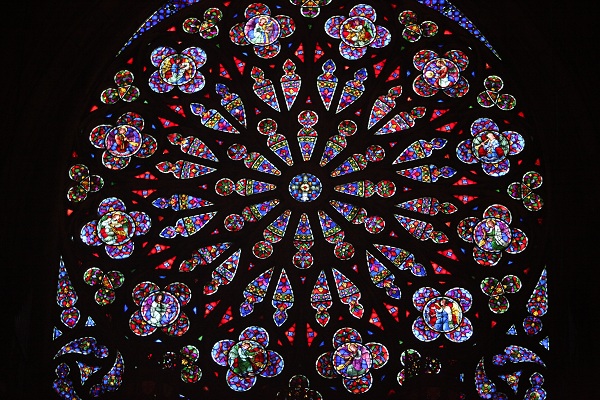
Holy Roman Empire
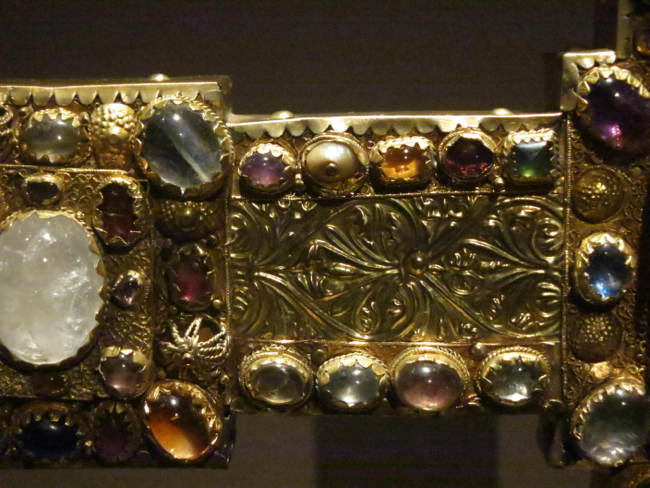
Website Highlights
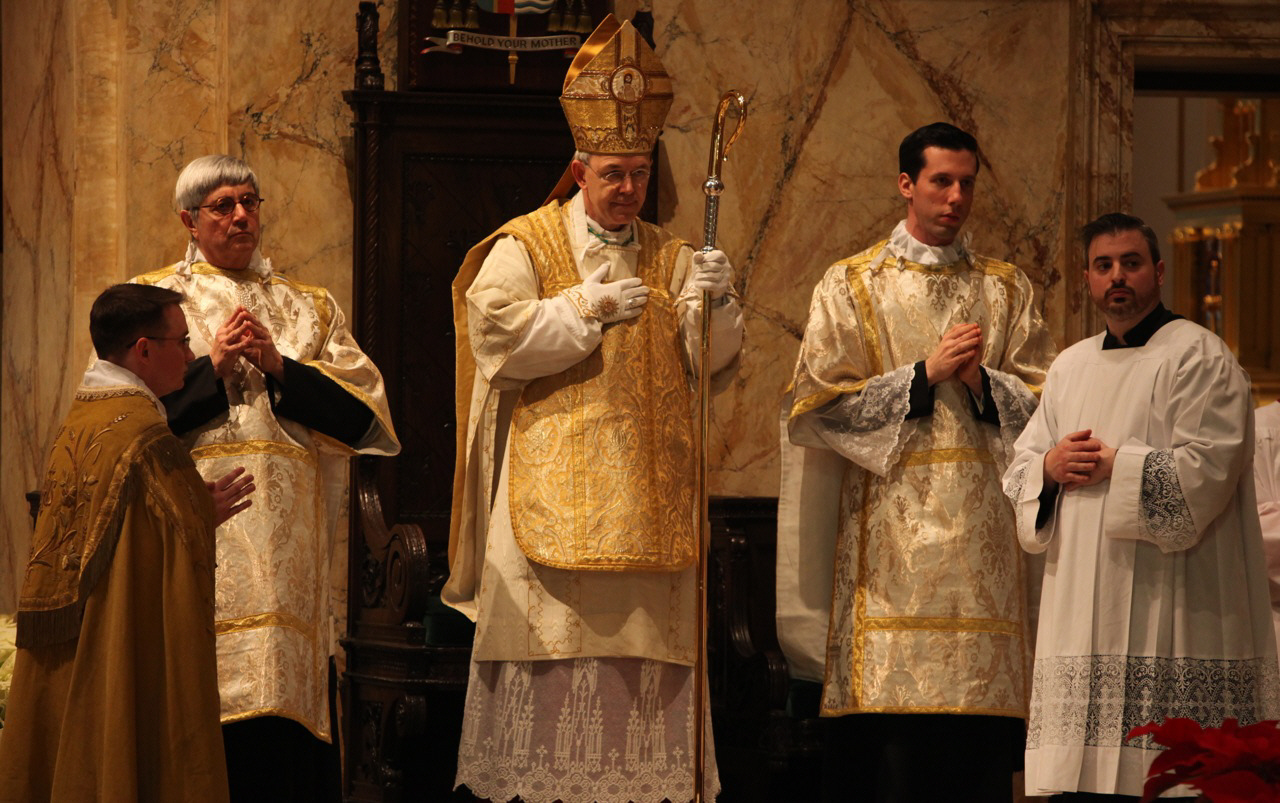
Archives
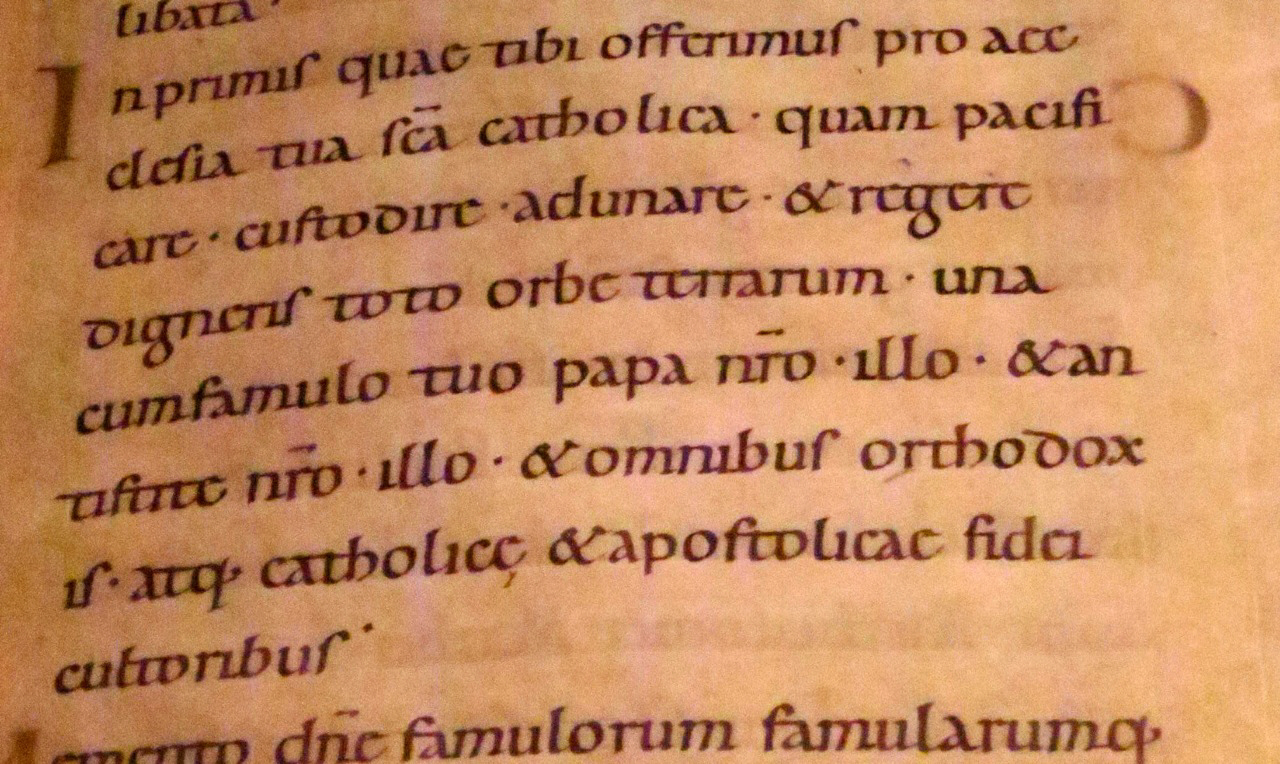
[powr-hit-counter label="2775648"]
